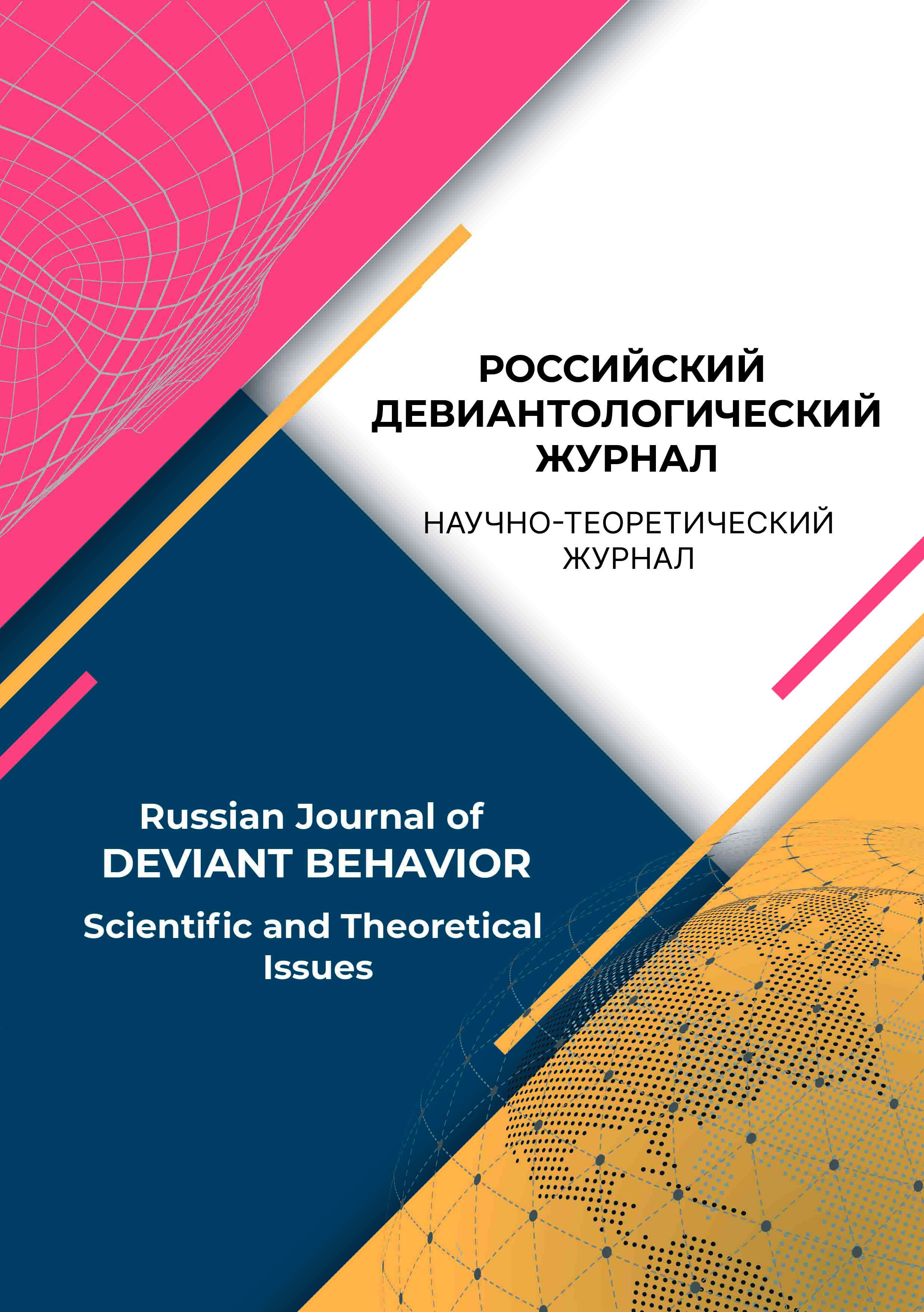Russian Federation
from 01.01.2018 until now
Russian Federation
Russian Federation
UDC 159.9
Introduction. The article is focused on identifying the main problem areas in the structure of individual indicators and the system of relations of adolescents accompanying the criminalization of behavior, with the aim of further improving the quality of diagnosis and correction of their personal characteristics. Research methods. The study examined the individual characteristics of 100 teenagers, half of whom had obvious signs of criminal behavior (they study in special closed institutions or are registered). The work analyzed the results of seven methods, three of which were adapted specifically for the purposes of studying a non-normative sample of adolescents. These are the methods of DDH, “Man in the Rain” and an essay on the topic “My Life”, which are rarely used in mass research. Results. Based on the results of the work, conclusions are drawn about the main negative and positive areas of adolescent development. Negative areas of development identified using research methods adapted by us include a pronounced conflict between the unconscious and conscious components in the field of family relationships, pronounced forms of external motivation, lack of orientation towards one’s own needs (low level of expression), inability to assess one’s internal resources and opportunities, lack of a clear attitude towards complex social values, decreased orientation towards the father. Promising aspects of adolescent development include recognition of the value of interests, orientation towards social desirability, external declaration of the “correct” values, and motivation based on external signs.
personality, adolescents, criminal behavior, value-motivational potential, system of relationships, researchmethods of the criminal behavior
1. Arbuzova, E. N., Burlakov, V. N., Lyubavina, M. A., Plotkina, L. N., Panov, A. M., SHCHurova, A. S., Burlakova, V. N. (red.) (2020). Narkotiki i molodezh’: strategii protivodejstviya: monografiya. Saint Petersburg: Yuridicheskij centr Press.
2. Arbuzova, E. N., Gorbatov, S. V. (2020). Nekotorye problemy razvitiya lichnosti v sovremennoj molodezhnoj srede. V Aktual’nye problemy psihologii pravoohranitel’noj deyatel’nosti: koncepcii, podhody, tekhnologii (Vasil’evskie chteniya - 2020): materialy mezhdunarodnoj nauchno-prakticheskoj konferencii (g. Sankt-Peterburg, 23 aprelya 2020, str. 39-43). Saint Petersburg: Sankt-Peterburgskij universitet MVD Rossii.
3. Bogdanovich, N. V., Delibalt, V. V. (2020). Profilaktika deviantnogo povedeniya detej i podrostkov kak napravlenie deyatel’nosti psihologa v obrazovatel’nyh uchrezhdeniyah. Psihologiya i pravo, 10 (2), 1-14. https://doi.org/10.17759/psylaw.2020100201
4. Dronova, T. A., Korneeva, Ya. A. (2021). Osobennosti socializirovannosti nesovershennoletnih iz neblagopoluchnyh semej. Psihologiya i pravo, 11 (3), 2-14. https://doi.org/10.17759/psylaw.2021110301
5. Vilkova, A. V. (2018). Prichiny, usloviya, predposylki, faktory vozniknoveniya i razvitiya deviantnogo povedeniya nesovershennoletnih. Ugolovno-ispolnitel’naya sistema: pravo, ekonomika, upravlenie, 2, 28-30.
6. Garnaeva, G. I., Shishova, E. O. (2023). Osobennosti psihologicheskih zashchit i koping-strategij nesovershennoletnih pravonarushitelej. Psihologiya i pravo, 13 (1), 107-118. https://doi.org/10.17759/psylaw.2023130108
7. Goncharova, S. V., Bushuev, I. V., Galda, M. V. (2018). Psihologo-pedagogicheskie aspekty vzaimodejstviya sotrudnikov podrazdelenij po delam nesovershennoletnih s poduchetnym elementom. V A. S. Dushkin, E. M. Marchenko (sost.), Pedagogika i psihologiya v deyatel’nosti sotrudnikov organov vnutrennih del: teoriya, metodika, praktika: materialy vserossijskoj nauchno-prakticheskoj konferencii (Sankt-Peterburg, 18 oktyabrya 2018 g., str. 70-74). Saint Petersburg: Sankt-Peterburgskij universitet MVD Rossii.
8. Kirillova, E. B. (2017). Vozrastnye razlichiya chert lichnosti podrostkov s deviantnym povedeniem. Penitenciarnaya nauka, 1 (37), 76-81.
9. Lebedeva, L. D., Nikonorova, Yu. V., Tarakanova, N. A. (2013). Enciklopediya priznakov i interpretacij v proektivnom risovanii i art-terapii. Saint Petersburg: Rech’.
10. Kornilova, T. V., Smirnov, S. D., Grigorenko, E. L. (2001). Faktory social’nogo i psihologicheskogo neblagopoluchiya podrostkov v pokazatelyah metodik standartizirovannogo interv’yu i listov nablyudeniya. Voprosy psihologii, 1, 107-122.
11. Nasledov, A. D. (2013). IBM SPSS Statistics i AMOS: professional’nyj statisticheskij analiz dannyh. Saint Petersburg: Piter.
12. Sapega, D. V., Bogdanovich, N. V. (2023). Osobennosti samoorganizacii podrostkov, sklonnyh k deviantnomu povedeniyu. Psihologiya i pravo, 13 (1), 135-151. https://doi.org/10.17759/psylaw.2023130110
13. Slavova, N. A., Chvyakin, V. A. (2019). Moral’no-nravstvennoe razvitie v strukture kul’turno-pravovoj organizacii lichnosti podrostkov s opasnymi social’nymi deviaciyami. Psihologiya i pravo, 9 (2), 264-275. https://doi.org/10.17759/ psylaw.2019090218
14. Sobchik, L. N. (2017). Kriminal’nye naklonnosti i psihodiagnostika. Psihologiya i pravo, 7 (1), 131-143. https://doi. org/10.17759/psylaw.2017070111
15. Suhov, A. N. (2022). Social’no-psihologicheskij analiz prestupnosti. Chelovek: prestuplenie i nakazanie, 30 (4), 633-640.
16. Shul’ga, T. I., Dvoryanchikov, N. V. (2020). Predstavleniya podrostkov o deviantnom povedenii. Psihologiya i pravo, 10 (3), 174-188. https://doi.org/10.17759/psylaw.2020100312
17. Downes, D. M., & Rock, P. E. (2007). Understanding Deviance: A Guide to the Sociology of Crime and Rule-breaking (5th ed.). Oxford, New York: Oxford University Press.
18. Cohen, A. (2016). Kriminelle Subkulturen. In D. Klimke & A. Legnaro (eds.), Kriminologische Grundlagentexte (pp. 269- 280). Springer VS, Wiesbaden. https://doi.org/10.1007/978-3-658-06504-1_16
19. Christian, R. E, Frick, P. J., Hill, N. L., Tyler L., & Frazer D. R. (1997). Psychopathy and Conduct Problems in Children: II. Implications for Subtyping Children with Conduct Problems. Journal of the American Academy of Child & Adolescent Psychiatry, 36 (2), 233-241. https://doi.org/10.1097/00004583-199702000-00014
20. Prideaux, S. J. (2010). The welfare politics of Charles Murray are alive and well in the UK. International Journal of Social Welfare, 19 (3), 293-302. https://doi.org/10.1111/j.1468-2397.2009.00660.x
21. Steinberg, A., Brook, J., & Remtulla, T. (2003). Youth Hate Crimes: Identification, Prevention, and Intervention. American Journal of Psychiatry, 160 (5), 979-989. https://doi.org/10.1176/appi.ajp.160.5.979
22. Stattin, H., Magnusson, D. (1989). The role of early aggressive behavior in the frequency, seriousness, and types of later crime. Journal of Consulting and Clinical Psychology, 57 (6), 710-718. https://doi.org/10.1037/0022-006X.57.6.710














